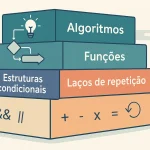Introduction: The Web that Connected the World
In the 21st century, the Internet has become an omnipresent force, permeating virtually every aspect of our lives. From instant communication with people on the other side of the world to access to an inexhaustible amount of information, through entertainment, commerce, and education, it has radically transformed the way we live, work, and relate to one another.
Therefore, for anyone living in the digital age, understanding what the Internet is, how it works, and its importance is fundamental. This article has been carefully crafted for you, the beginner, seeking to demystify this global network and understand its foundations in a clear and accessible way.
Simplifying the Concept: What Does “Internet” Mean?
In essence, the Internet is a vast global network of interconnected computer networks that use a standardized set of communication protocols, primarily TCP/IP (Transmission Control Protocol/Internet Protocol), to exchange data and information. In other words, imagine a complex worldwide web connecting millions of computers, servers, smartphones, tablets, and other devices, allowing them to communicate and share resources with each other.
Thus, it is not a single physical entity but rather a logical infrastructure that unites countless smaller networks belonging to different organizations, governments, companies, and individuals around the world. The beauty of the Internet lies in its ability to enable communication and information sharing in a decentralized and global manner.
The Pillars of Connection: How Does the Internet Work?
The functioning of the Internet may seem complex at first glance, but it is based on a few fundamental principles:
TCP/IP Protocol:
Firstly, TCP/IP is the set of rules that governs all communication on the Internet. IP (Internet Protocol) is responsible for addressing devices on the network, assigning each one a unique address (the IP address) that allows it to be identified and data to be routed correctly. TCP (Transmission Control Protocol) ensures the reliable transmission of data, dividing it into packets, verifying their integrity, and retransmitting lost packets.
Routing:
Next, data traveling over the network is divided into small pieces called packets. These packets travel through a vast network of routers, which are specialized hardware devices for directing data traffic to its correct destination, like digital “mail carriers.” Routers analyze the destination IP address of each packet and determine the best route for it to follow.
Servers:
Additionally, much of the information and services available on the Internet are hosted on servers, which are powerful computers designed to store data (such as web pages, videos, files) and respond to user requests. When you access a website, for example, your computer sends a request to a server where that website is hosted, and the server sends the page data back to your computer.
Clients:
Furthermore, the devices users utilize to access (such as computers, smartphones, and tablets) are called clients. They send requests to servers and display the received information.
DNS (Domain Name System):
Finally, DNS is a system that translates the user-friendly domain names we type into browsers (like www.google.com) into numerical IP addresses that computers understand. This makes navigation much easier and more intuitive for users.
Physical Infrastructure:
Behind digital communication, there is a vast physical infrastructure that supports the Internet, including submarine and terrestrial fiber optic cables, satellites, cell towers, and other network equipment. This infrastructure enables the transmission of data signals over long distances.
A Brief Journey Through Time
The Internet did not emerge overnight. Its history is fascinating and dates back to the Cold War:
- ARPANET (1969): Its precursor was ARPANET (Advanced Research Projects Agency Network), created by the United States Department of Defense with the aim of connecting researchers at different universities and institutions, allowing the sharing of computational resources.
- Development of TCP/IP (1970s): The development of the TCP/IP protocol suite was a crucial milestone, as it provided the basis for a network of interoperable networks.
- Adoption of TCP/IP (1983): On January 1, 1983, ARPANET officially adopted TCP/IP as its standard protocol, marking the birth of the Internet as we know it today.
- Expansion and Commercialization (1980s and 1990s): The Internet began to expand beyond the academic and scientific community, with the emergence of networks like NSFNET (National Science Foundation Network) and the subsequent commercialization of network access.
- Creation of the World Wide Web (1989): Tim Berners-Lee, at CERN (European Organization for Nuclear Research), invented the World Wide Web (WWW), a system of interconnected documents via hyperlinks, which revolutionized how people access and share information online.
- Popularization of the Internet (1990s and 2000s): With the emergence of user-friendly web browsers and the expansion of network infrastructure, the Internet rapidly gained popularity, becoming accessible to millions of people worldwide.
The Essence of Interaction: What Can We Do on the Internet?
There is an incredibly wide range of possibilities and services:
- Communication: Sending and receiving emails, instant messages, voice and video calls, social networks.
- Information: Access to an inexhaustible amount of knowledge, news, articles, research, and educational resources.
- Entertainment: Streaming videos and music, online games, access to movies, series, and other multimedia content.
- E-commerce: Buying and selling products and services online.
- Education: Online courses, learning platforms, access to educational materials.
- Banking and Financial Services: Conducting banking transactions, online investments.
- E-Government: Access to online public services, government information.
- Social Networks: Connecting with friends, family, and people with common interests.
- Collaboration: Tools for teamwork, file sharing, and online projects.
- News and Media: Access to newspapers, magazines, and other information sources from around the world.
This list is far from exhaustive, and new applications and services constantly emerge on the Internet.
The Protagonists of the Network: Who Keeps the Internet Running?
The Internet is not controlled by a single entity. Its operation depends on the collaboration of various organizations and individuals:
- ICANN (Internet Corporation for Assigned Names and Numbers): Responsible for coordinating the Domain Name System (DNS) and allocating IP addresses.
- ISPs (Internet Service Providers): Companies that provide Internet access to end-users and other organizations.
- Standardization Organizations: Such as the IETF (Internet Engineering Task Force) and the W3C (World Wide Web Consortium), which develop the technical standards and protocols for the Internet and the World Wide Web.
- Infrastructure Companies: Companies that build and maintain the physical infrastructure of the Internet, such as fiber optic networks.
- Software and Hardware Developers: Creators of the software and equipment that enable communication and access to the Internet.
- The Internet Community: Millions of individuals and organizations that contribute to the development, operation, and evolution of the Internet.
The Vital Importance: Why is the Internet Crucial in Today’s World?
It has become a critical infrastructure for modern society, profoundly impacting various sectors, for example:
- Economy: Facilitates global trade, drives innovation, creates new business models, and increases productivity.
- Education: Additionally, it offers access to online learning resources, democratizes knowledge, and facilitates distance education.
- Communication: Enables instant and global communication, connecting people and cultures.
- Government: Facilitates the provision of online public services, increases transparency, and allows for citizen participation.
- Health: Enables telemedicine, access to health information, and the exchange of knowledge among professionals, for example.
- Culture and Entertainment: Finally, it offers access to diverse forms of cultural expression and entertainment.
- Science and Research: In summary, it facilitates collaboration among scientists, data sharing, and access to scientific publications.
In short, the Internet is a powerful tool that has transformed society on a global scale, becoming essential for social, economic, and cultural development.
Navigating Safely: Essential Precautions on the Internet
Despite its numerous benefits, the Internet also presents risks that require attention and care:
- Malware: Malicious software (viruses, worms, trojans) that can damage devices and steal information.
- Phishing: Attempts to obtain confidential information (passwords, bank details) through fake emails or websites.
- Cyberattacks: Attempts at unauthorized access to systems and networks.
- Fake News and Disinformation: False or misleading content that can influence opinions and cause harm.
- Privacy: The collection and use of personal data online raise important questions about privacy.
To navigate the Internet safely, above all, it is fundamental to use updated security software, be careful with suspicious links and attachments, protect your personal information, and verify the credibility of information sources.
The Digital Horizon: The Future of the Internet
The Internet continues to evolve at an accelerated pace, driven by new technologies and demands, for example:
- Internet of Things (IoT): The growing connection of everyday objects to the Internet.
- Artificial Intelligence (AI): The integration of AI into various online services and applications.
- Virtual Reality (VR) and Augmented Reality (AR): New ways of interacting with the digital world.
- 5G and Next Generations of Mobile Networks: Promise faster and more reliable connections.
- Web 3.0: A vision of a more decentralized and blockchain-based Internet.
- Metaverse: Immersive virtual spaces where people can interact.
These trends indicate that the Internet will continue to transform our lives in still unpredictable ways.
Conclusion: Connecting to Knowledge and Innovation
In conclusion, the Internet is much more than just a network of computers; it is a global web of information, communication, and opportunities that has shaped the modern world. For beginners, understanding its fundamentals, history, and impact is the first step to navigating this vast digital universe with confidence.
Remember that the Internet is a powerful tool, and like any tool, its responsible and conscious use is fundamental. Explore, learn, connect, but always with safety and discernment. Knowledge about what the Internet is and how it works is an essential passport for digital citizenship in the 21st century.
Therefore, continue exploring this fascinating global network. Learning about the Internet is a continuous journey, full of discoveries and possibilities. Connect to the knowledge and innovation that the Internet offers, and be part of this constantly evolving digital revolution.
Did you like the article? Check out more here.









